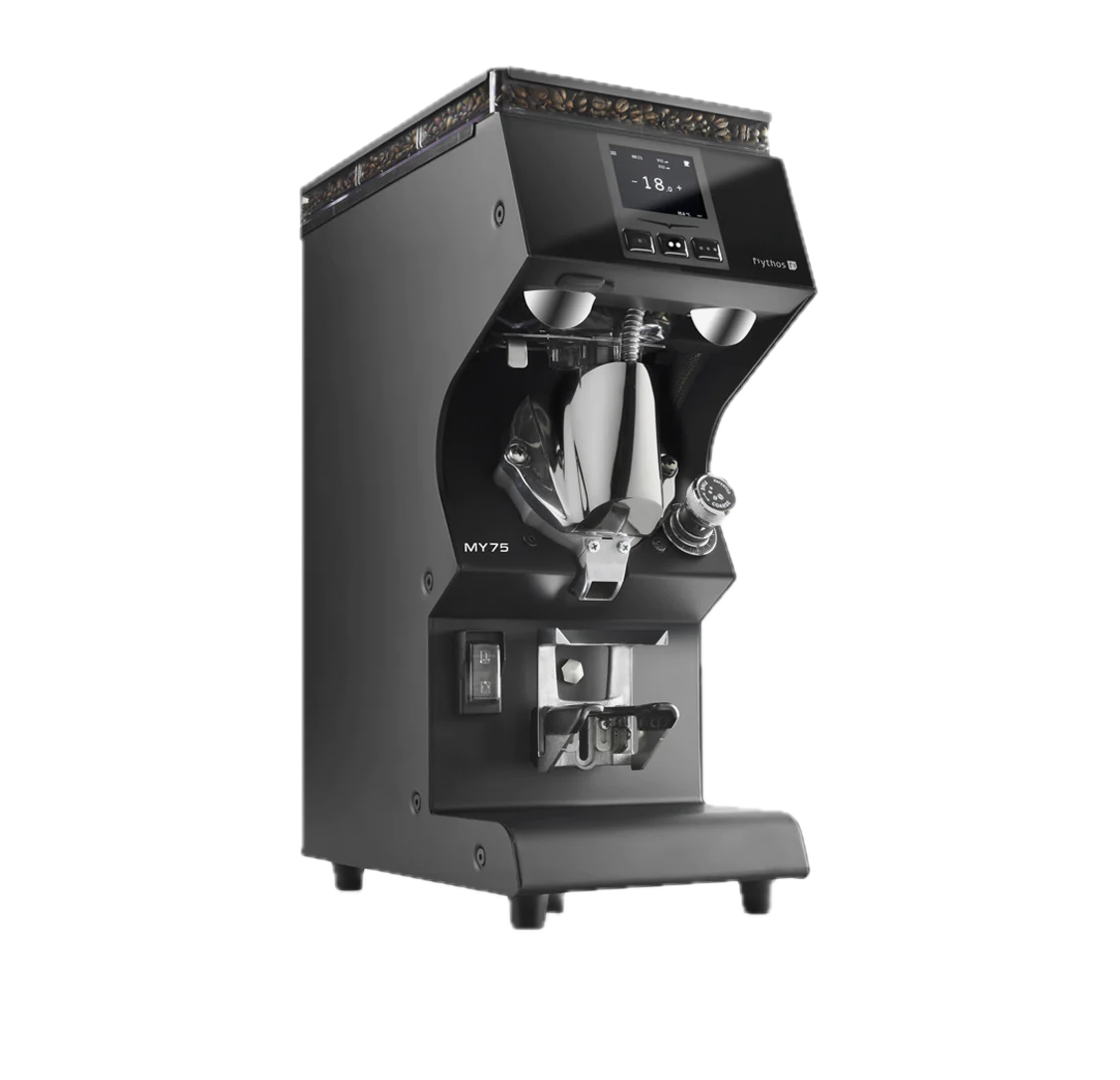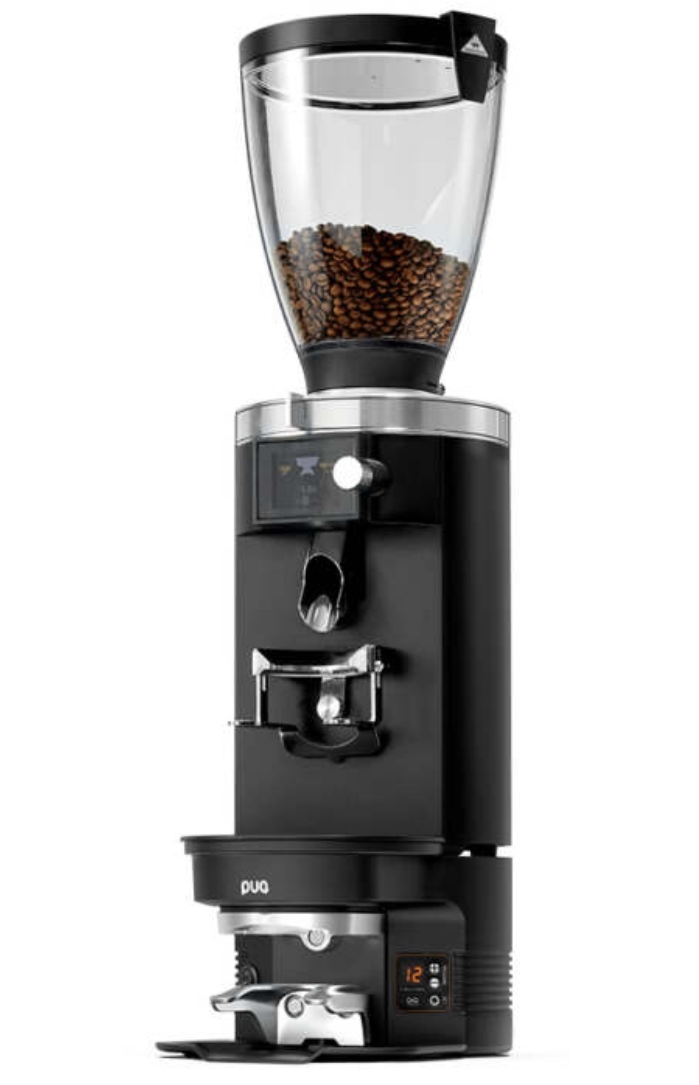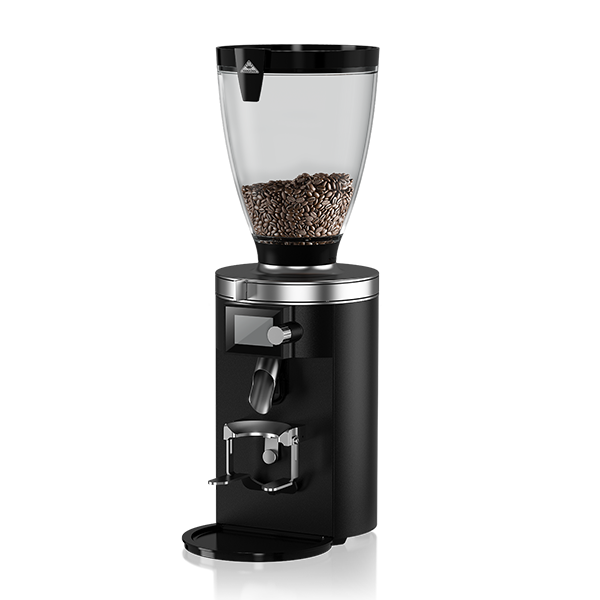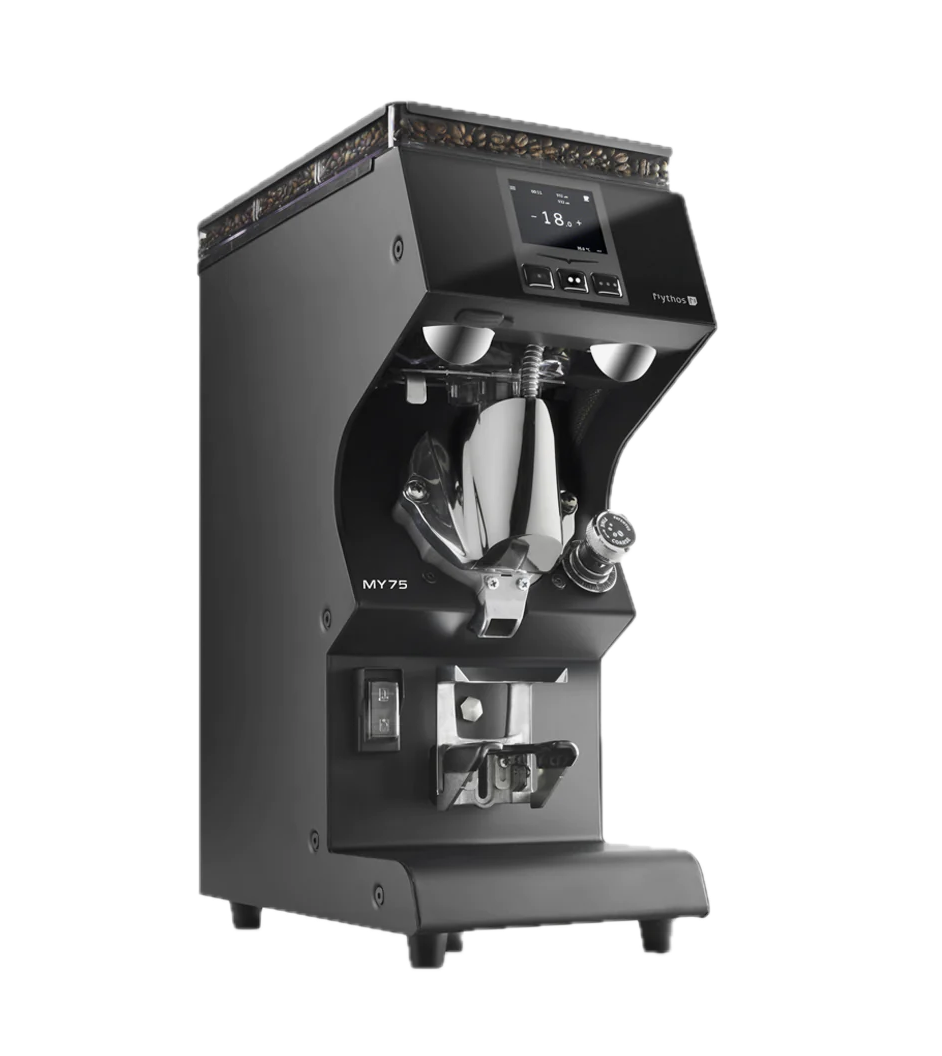Two of our favourite coffee grinders for busy coffee shops here at Bridge, are the E65S by Mahlkonig and the Mythos MY75 by Victoria Arduino.
Both of these grinders are exceptionally capable at producing consistent cups of coffee thanks to their uniform grind profile, along with assisting in the barista workflow with their speed, ease of use, and optional add-on grind by weight and gravimetric technologies. Having used both grinders professionally, I can happily say that these two grinders provide an excellent quality of coffee and workflow. However, there are some differences you should be aware of if you’re considering picking one of them up.
In this article we’re providing a quick comparison of the specs, pricing, features and design options for the E65S and Mythos MY75 grinders. Before we get into the head-to-head comparison, here’s the individual specs…


Mythos MY75 Product Specs
The MY75 is an iterative improvement from the Mythos One and MYONE espresso grinders by Victoria Arduino. The grinder’s standout features include the ‘clima’ temperature control of the burrs, the fast grinding speeds and clump crusher that ensures a high quality grind profile.
- Long Life Titanium Coated 75mm burrs
- 1.5kg bean hopper
- 600W (230V)
- 50/60Hz
- 2.7-3.5 grams per second
- 23.8kg
- Clump crusher
- Clima pro temperature control


Mahlkonig E65S Technical Specs
The E65S Mahlkonig coffee grinder is fitted with multi-functional turn and push buttons which make it easy to control during busy periods, as well as a simple to adjust spout which can be removed to fit any portafilter.
Another key feature of this espresso grinder is the ‘silent grind’, which makes it perfect for use in commercial environments. There is also an innovative menu icon and 6 individual programmable recipes included for you to use. The E65S Mahlkonig is great all round espresso coffee grinder, suitable for use in many businesses.
- 65mm Flat Burrs
- Uniform Grinding Profile
- Intuitive Menu
- Up to 6 Recipes Programmable
- Quiet grinding
- Quick, Stepless and Single-Handed Grind Adjustment
- Adjustable and Removable Spout
- 1kg+ Bean Hopper
- Universal, Robust Portafilter Holder
Let’s compare the E65S and MY75
Price
Let’s keep this short and sweet. The MY75 currently starts at £2,360, whereas the E65S starts at £1,780. (These are our starting list prices for wholesale, actual price may vary).
Each grinder starts off with the time-based dosing, but each come with optional weight-based dosing. The E65S Grind by Weight is price from £2,100, whereas the MYG75 Gravimetric version is prices at £2,490.
So based on pricing, the E65S takes the win by quite a distance. Where the best value for money lies, however, is up for debate. Continue reading to see what your money buys with each grinder.
Grind Speed
This is an important factor for many, particularly in commercial settings where long wait times can significantly impact revenue and customer satisfaction.
The MY75 is advertised as producing 2.7 to 3.5 grams of coffee per second into the portafilter. For an 18 gram dose, that’s an average grinding time of 5.1-6.6 seconds for a double shot.
In comparison, when dialled for an 18 gram dose, the E65S grind by weight reliably came in at 5 seconds. So, very minimal differences in grind speed but on average the E65s grinders came out on top.
Note that the GBW and Gravimetric versions of the grinders don’t grind any faster, they’re just slightly more accurate in dosing.
Hopper Capacity and Retention
Hopper capacity is another easy comparison. The MY75 and all Mythos grinders come with a large 1.5kg hopper that blends in seamlessly with the overall grinder shape, whereas the E65s has a traditional hopper that can hold just over a kilo of coffee comfortably.
For the coffee hopper, once again we’ll give the winning point to the MY75 and mythos grinders. The hopper is not only larger, but fits perfectly inside the overall design of the grinder, and with the majority of the hopper being hidden inside the grinder there is less sunlight shining on the beans which could help with freshness.
Grind Quality
Now, this review isn’t going to be a deep dive into burr geometry, grind uniformity and particle distribution. If you’re interested in that kind of thing, there are plenty of videos on YouTube deep diving into the subject.
These grinders are built for commercial settings, and the grind quality you get from both are absolutely ‘endgame’ in our view. The included burr sets both lean towards a uniform grind size that targets sweetness and clarity in your espressos, and are perfectly suited to medium and light coffees.
Despite their similarities, there is one obvious point of differentiation in the size of the burrs: the 65mm E65S burrs vs the 75mm MY75 burrs. Practically there is no major differences between the grinders purely based on there burr sizes, as the smaller burrs actually grind faster and grind profiles are very similar.
So there’s no clear winner in terms of grind quality but when you add price into the equation, grind quality value for money goes to the E65s. It’s also worth noting that both of these grinders feature a larger sibling boasting 85mm flat burrs, those being the E85S and the MY85.
User Experience
I’ve personally used both of these grinders in commercial settings, during my past life as a part-time barista and through plenty of events, trade shows, customers tastings and daily coffees here at Bridge.
User experience during daily operation is largely the same: Lock in portafilter, wait for coffee, remove portafilter. However, where the differences lie is when you’re looking to make changes to the settings or grind size.
The Mythos grinders, MY75 included, feature a worm-drive grind adjustment dial that lets you make minute changes to the grind size using the knob on the front. This system lets you adjust the grind size by really tiny amounts, allowing for easy fine-tuning of the extraction when you’re just outside of your target time or flavour profile.
The one drawback of this system, though, it that it’s slightly difficult to keep track of your grind size when making large adjustments, and unless you have a good amount of experience it’s hard to know just how much of a change you’re making.
With the e65s grinders, you have a paddle sat across a dial ring that you push left for finer and right for coarser, with numbers guiding your adjustments. Though it is slightly more difficult to make miniscule adjustments (though still relatively easy), it is a much more user friendly experience.
Both the MY75 and E65S grinders come with a built in screen and a series of buttons for selecting doses and making adjustments. We prefer the user interface offered by the MY75 with a touchscreen for making changes, and three simple intuitive buttons for selecting three different doses.
Which is Best? E65s VS MY75 Espresso grinders
If you read this far and you’re still wondering which of these two grinders is the best, then you might benefit from a little guidance and consultation. If that’s the case, feel free to ask us as many questions as you like: Get in touch.
In summary, neither of these grinders is far better than the other. They vary slightly in features and in price, and we may recommend either grinder depending on your situation and use case. Using the specifications and differences we’ve outlined above, it’s your time to decide which of these two grinders is best for you.



